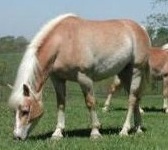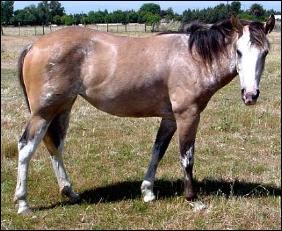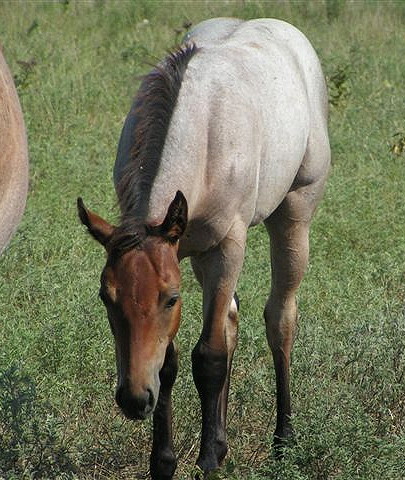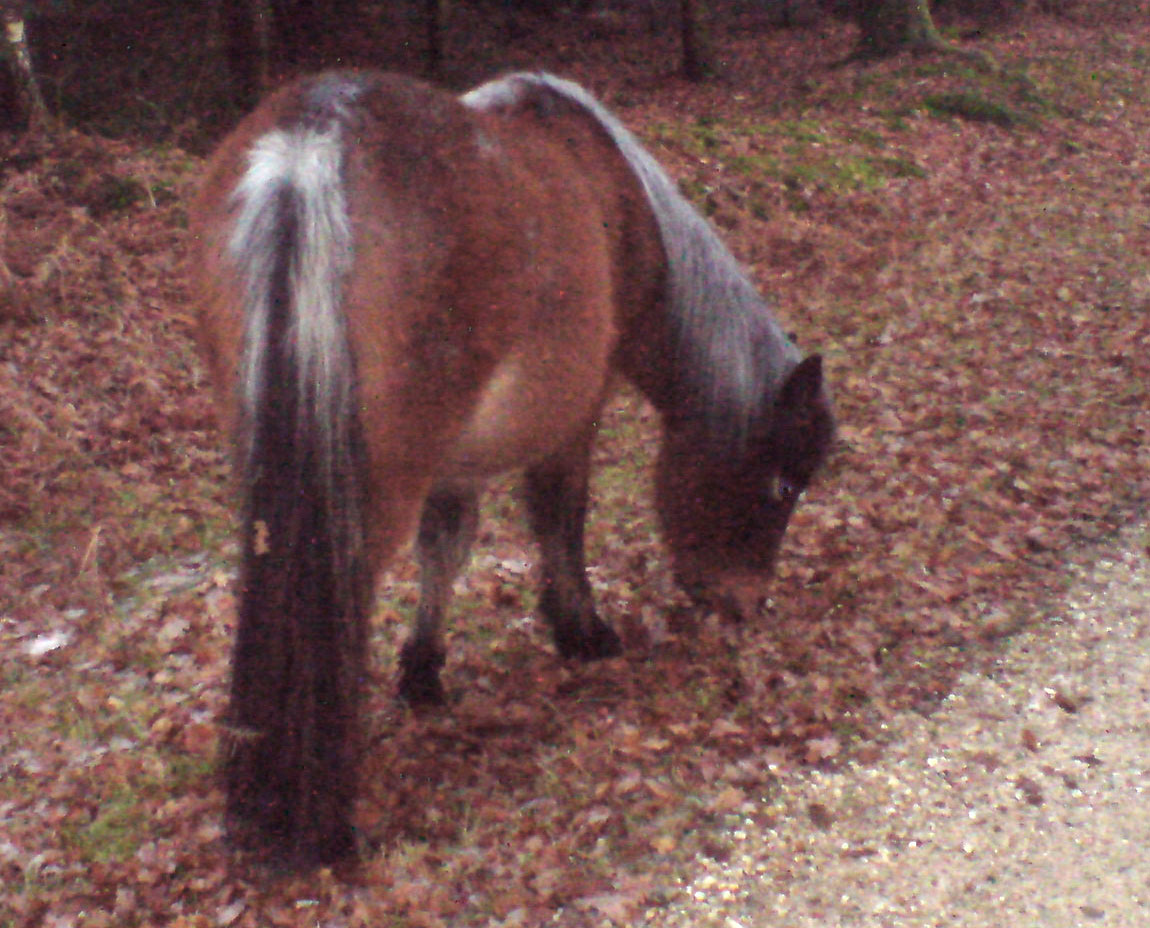| There are many genetic modifiers
which can be applied to a basic whole coat colour, and some
of the best known of these are the dilution factors of dun,
cream, silver, champagne and pearl.
Each of these can be related to a specific known gene,
which (if present) can have been inherited from one parent
or both parents. They can appear in combination with each
other; a horse could theoretically have, for
example, one helping of cream, one of dun, two of silver,
one of champagne, two of pearl - or any other possible
combination. (Mathematicians will already have worked out
by now that that gives you an awful lot of
possible genetic dilution variations on any basic
non-dilute coat colour, depending which of these dilution
factors is present.)
Many of these combinations can be visually similar, and
so are often lumped together under a common name. For
example, a cream dilution factor of "one" acting on a bay
base coat will give you a buckskin, and a dun dilution
factor acting on a bay base coat will give you yellow or
golden dun. (Buckskin can be additionally modified by the
sooty gene, but there is some evidence to suggest
that the dun gene suppresses the action of sooty.)
They are very similar - the only real visual difference is
the presence of primitive markings
on the dun. Simple rule: no eel-stripe, no dun. Also, a
true golden dun's body coat will have more the colour of
set honey or vanilla-cream fudge, and the buckskin's body
coat will be more clear gold and like a palomino's coat.
In many countries, buckskins are called yellow dun or
golden dun, and people are loath to change the name by
which they know a colour; there are some people for whom
the word "buckskin" is too American! In other countries -
particularly America - golden duns are called buckskin
duns. It all adds to the confusion. If your 'alleged dun'
horse is descended from a non-dun parent and a palomino or
cremello parent, he's a buckskin, not a dun. In addition,
champagne can act on bay to produce a very similar-looking
coat colour (known as amber).
These 'mixers' act in slightly different ways. Some
affect the uptake / production of
pigment into the shaft of the hair (and tend to affect one
pigment either to the exclusion of the other, or more than
the other), and others affect the distribution
of pigment granules within the hair shaft, and tend to
affect both red and black pigment equally. This is why one
can't 'see' the silver gene on a chestnut horse , as
silver only affects the uptake of black pigment,
and one can't 'see' the flaxen gene on a black-based
horse, as it only affects the uptake of red
pigment. The agouti gene only affects the distribution
of black pigment, which is why one cant 'see' it in
chestnut horses.
Dun can dilute both red and black coat pigment.
The dun gene is a simple dominant - if you've got it, it
shows, and it will have shown it at least one parent. The
dun gene seems to affect the distribution of pigment
granules in the hair, moving pigment away from the
'air-side' of the hair and towards the 'skin-side' of the
hair, leaving the part of the hair which is clearly
visible with much fewer pigment granules - hence the
dilution of visible colour. It is the one responsible for
the primitive
markings of dorsal stripe, shoulder stripe, and
zebra / tiger stripes. "Cobweb" markings can also appear
on the forehead. Additional dun markings are face mask,
neck and / or shoulder shadowing, 'barbs' from the
dorsal stripe, and ear tipping, outlining and barring.
Duns also have dun dilution (the same colour as the body
coat or a few shades lighter) at the sides of the mane
and the frost-cap at the top of the tail. Dun doesn't
touch the lower legs, so it's what I call a 'pattern
dilutant'. To the best of current knowledge there
appears to be no visual difference if a horse has
inherited one or two dun dilution genes. If he has
inherited the dun gene from both parents, of course, he
will pass it on to ALL his descendants. For (probably)
the best article on distinguishing between true duns and
buckskins (cream dilutes) with counter-shading caused by
the sooty gene, see Dun Central Station's excellent
article "What's
Dun is Dun!"..
Breed Societies, please try to ensure that duns are
registered under their right colour! It's unhelpful when
researching pedigrees if every type of dun is simply
registered as 'dun', as opposed to golden dun, mouse dun,
blue dun, (any of which could be 'silvered'), and red dun,
etc.! And please don't register buckskins as
duns! Pictures of 'true duns' and colours frequently
confused with (and mis-registered as) dun can be seen on
our 'Dun and Un-Dun' page.
Cream in a single dose dilutes only red
hairs. Cream is an 'incomplete dominant' - a double dose
will give you more dilution than a single dose, and a
single dose is hard to spot on a black coat. The cream
gene affects the uptake of pigment into the hair - each
hair contains less pigment than the basecoat unmodified by
the cream gene. A double dose gives you double dilution,
can affect black hairs, too, and reduces the production of
skin pigment. But it also interacts with the
recessive pearl (both genes affecting
the production rather than the distribution of pigment
granules) to produce what appears to be a
double-cream dilution (cremello / perlino). Cream is a
'flat dilutant' - affects the whole coat pretty evenly -
but often gives slight dappling.
Champagne, like dun, dilutes both red and black
pigments, but does NOT produce the primitive markings. The
champagne gene, like the dun gene, is a simple dominant -
if you've got it, it shows, and it will have shown it at
least one parent. Like the dun gene, it affects the
distribution of pigment granules in the hair, completely
(or almost completely) removing pigment granules from the
core of the hair shaft into the surrounding cortex. The
core is translucent - giving the 'metallic gloss' or
'translucent glow' to the coat, as opposed to the opaque
colour of the non-champagne coat. Champagne horses are
born with brown hooves, pink skin, and blue eyes which
eventually (and gradually) become hazel, amber or
occasionally blue-green at adulthood. They tend to be born
with relatively dark coats, which fade out later. (A foal
born 'chestnutty' with blue eyes, which turns 'goldy' with
hazel eyes, is likely to be a gold champagne.) I would
classify champagne as a 'flat dilutant'. Do note, some
other 'dilutes' can be born with blue eyes which darken
within the first week of life, but champagne eyes only
darken gradually. Champagne skin shows distinct freckling
in the 'soft' areas (muzzle, around eyes, genitalia and
dock) and is 'goldenish' under chestnut hair and
'bronze-ish' or 'chocolate-ish' under dark hair.
Silver dilutes only black hairs, and is the gene
responsible for the silvering of dark (i.e. including
black) manes and tails. (Don't confuse rabicano
roaning in the mane, and rabicano 'skunk-tail',
for silver gene dilution.) The silver gene is a simple
dominant, and affects the uptake of black pigment into the
hairs, predominantly in the coarser mane and tail hairs.
(Flaxen acts the same way on red / chestnut pigment.) The
silver gene originated in the pre-historic Northern
British ponies, probably around the close of the last ice
age, from where it was taken by the Vikings to Iceland.
Current distribution of the gene in the 'older' breeds
suggests it originated in Britain rather than Scandinavia,
as the silver gene appears in Shetlands but not
in the Norwegian Fjord Horse. It is very common in the Icelandic horses.
It's likely that there is more than one variant (or
allele) of the silver gene. It's important not to lose the
silver gene - by accident or on purpose! - from the breeds
where it's likely to be a native gene; this would include
the Shetlands and Welsh ponies (definitely), and the
Highland and New Forest ponies (probably).
Breed Societies, please be careful (where you can) to
ensure that chocolate flaxes and chocolate dapples aren't
registered as liver chestnuts, silver bays aren't
registered as flaxen chestnuts, and silver gold duns
aren't registered as palominos. For breeders looking
either to include or to exclude specific colour genes,
it's helpful to know what has them!
Pearl is a recessive gene which can
interact with cream, and is a 'flat dilutant' rather than
a 'pattern dilutant'. One dose of pearl
won't change the coat colour of black, bay or chestnut
horses (unless interacting with cream), but does
appear to affect the skin colour, producing pink speckles.
The pearl gene affects production / uptake of pigment. Two
doses on a chestnut background produce, in adulthood, a
uniform apricot / peach / pale golden colour of body hair,
mane and tail, with pink / pale skin, and pale eyes
(ageing to an amber colour). Double-pearl foals are
generally pale cream, the coat gradually turning golden
later. Pearl (at present) appears in
horses with Spanish ancestry, or those descended from a
horse called My Tontime, the grand-dam of Barlink Macho
Man. It also seems to occur in some Gypsy horses (probably
again due to a Spanish inheritance). It has also been
known as 'apricot' or 'Barlink factor'. Pearl + cream on a
black basecoat produces 'smoky pearl' horses, and on a bay
basecoat produces a colour very similar to perlino.
The "UFO's" of genes:
'fading black / light black'. I'm
including it with the dilutants for two reasons. Firstly,
it's my web page, so I can! Secondly (and more
logically), it's because I strongly suspect that this,
when isolated and identified, will eventually be shown to
be a recessive or partially-recessive gene. It seems
likely that the actual mechanism behind 'fading black' is
to do with the production (synthesis) of eumelanin, and a
form of eumelanin is produced which is 'photo-unstable'
(i.e. breaks down on exposure to light). It also seems
likely that there is a an interaction with at least one
other gene, as the fading can be produced with or without
patterning. 'Fading black' does appear in
families - so it's almost certainly genetically produced,
and this means that it will, one day, be properly
identified and located. A good place to start
looking for this (suggested) gene would be on ECA3
(chromosome 3) as this is where the genetic information
for the production of eumelanin is located - in the
Extension gene. It's possible that it may simply be
another variation of the (dominant) E allele, as has been
suggested for 'dominant black' (E+, or ED). If
this does turn out to be the case, perhaps 'fading black'
could be signified by Ef).
'Mushroom'.
This colour has been
appearing in Shetland (and possibly Icelandic) ponies,
predominantly in those which should be chestnut
according to the breeding. Some have been genetically
confirmed to be a definite chestnut base coat. The
colour can vary from 'pale mushroom' (almost creamy) to
'dark mushroom' (similar to the Chocolate Flax). Coats
often start off darkish with each coat change, but fade
over time. Under the mane, where light doesn't hit, they
tend not to fade. Mushroom ponies appear in lines where
the cream gene is absent, and don't throw cream dilutes.
Silver gene (which in normal circumstances doesn't show
on chestnuts anyway) seems to have been eliminated as a
possibility. Could this be a 'fading sooty'? Could it be
a so-far-unknown gene acting on sooty?
Whatever eventually turns out to be the case, at
present both fading black and mushroom come into the
category of the many puzzling, frustrating or irritating
factors probably caused by one of the proverbial
'damned-if-I-know' genes .......
(Given a free rein, I would also include pangare
and flaxen with the dilutants, as 'pattern
dilutants' - i.e. not affecting the entire coat but
clearly diluting parts of it in a readily-identifiable
pattern.)
Some of the best
examples across the range of 'diluteds' come from the Highland
ponies, the American
Quarter Horses, Norwegian
Fjord Horses, and the primitive wild varieties -
which, as they evolved naturally, one shouldn't really
call 'breeds'.
The table below gives a visual description - not
necessarily a genetic explanation - of a number of "names
by which colours are known."
|



